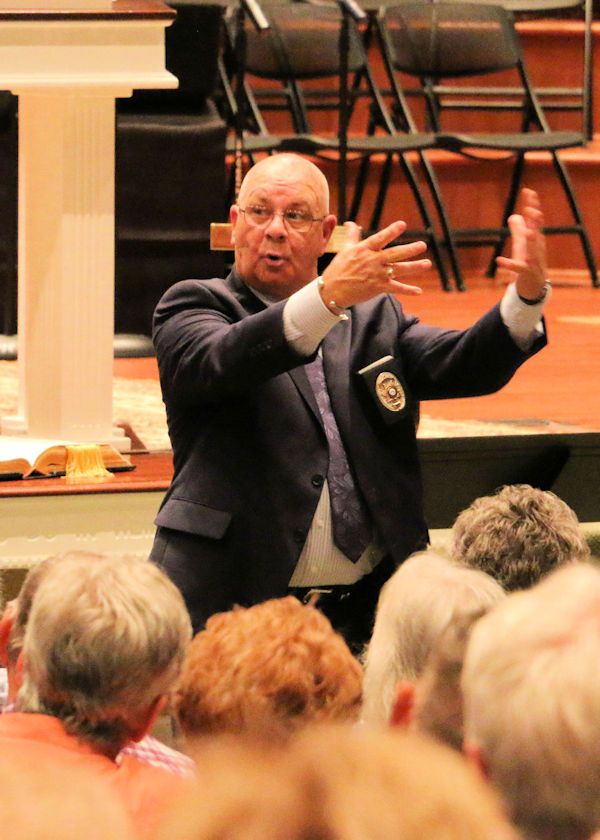Surviving an active shooter requires awareness, focus, quick thinking — and the willingness to act.
That was the message residents took from a special training event hosted by Tanner Health System, the Villa Rica Police Department and First Baptist Church Villa Rica. The organizations partnered to share tips on ways residents can improve their chances of surviving an active shooter and how to save lives in the aftermath of such an event.
 Thursday night, more than 300 residents filled the pews at First Baptist Church Villa Rica to join certified master trainer Officer Perry Baxter and board-certified emergency medicine physician Richard Warren, MD, as they led the presentation “Avoid | Deny | Defend: Surviving an Active Shooter.”
Thursday night, more than 300 residents filled the pews at First Baptist Church Villa Rica to join certified master trainer Officer Perry Baxter and board-certified emergency medicine physician Richard Warren, MD, as they led the presentation “Avoid | Deny | Defend: Surviving an Active Shooter.”
The two-hour educational event focused on methods to avoid an active shooter, including tips on avoiding the situation by being aware of your surroundings and locating exit points, ways to deny an attacker by safely sheltering in place and barricading doors and entryways and, if necessary, fighting back and doing whatever it takes to defend yourself against a shooter.
Throughout the training even, Baxter played clips from actual past active shooter events, including a 911 call from a teacher during the 1999 Columbine High School shooting in Columbine, Colo., where 15 people were killed, as well as the 2010 Panama City School Board shooting incident from Panama City, Fla., where individuals took action against the shooter.
During both clips, Baxter noted the importance of getting past one’s natural emotional responses to quickly consider how to take action during the event.
The night’s presentation also covered ways people involved in an active shooter event can help save victims who were wounded in the attack.
Dr. Warren, a residency-trained emergency physician and chair of emergency medicine at Tanner Health System, shared medically-based methods that even non-clinical individuals can use to immediately provide life-saving assistance to people injured during an active shooter situation.
He explained how items such as belts can be used as tourniquets applied two to three inches above a bleeding wound, and how articles of clothing can be used to apply steady compression, as two methods to stop a wound from bleeding until emergency services arrives, which could potentially save a loved one’s or a neighbor’s life.
 Baxter has been holding active shooter trainings for more than 10 years. He explained that active shooter events can unfold anywhere and the best way to ensure that you, your loved ones and other people around you have the best chance to survive an attack is to stay calm, get out if you can and — when absolutely necessary — fight back.
Baxter has been holding active shooter trainings for more than 10 years. He explained that active shooter events can unfold anywhere and the best way to ensure that you, your loved ones and other people around you have the best chance to survive an attack is to stay calm, get out if you can and — when absolutely necessary — fight back.
“You’ve got to stay calm and get out as soon as you can, and if you can’t get out, then barricade yourself where the attacker can’t get to you and know that you can fight back,” said Baxter.
Baxter explained that law enforcement officers study these tragic events and train for them regularly, but an average person, in the height of emotion and panic of an active shooter situation, isn’t as prepared. These training events teach residents what potentially life-saving decisions they can make in the case of active shooter attack.
“The majority of people aren’t prepared to respond to these types of situations; we are,” he said. “But it can often take up to three minutes for law enforcement to arrive. This training program is the best way I have found to inform people so they are aware that these things can happen and that they can escape and protect themselves in case they do happen. These situations are a big problem in our nation’s communities, and until we find a way to fix these problems, the best way to prepare people is to get the word out.”
More upcoming educational opportunities throughout the region can be found online at www.tanner.org/calendar.
Photo captions:
Perry Baxter (top photo), training officer for the Villa Rica Police Department, discusses the importance of being aware of one’s surroundings — including available exits — during the “Avoid | Deny | Defend” active shooter survival training event May 10 at First Baptist Church Villa Rica. The program was sponsored by Tanner Health System, the Villa Rica Police Department and First Baptist Church Villa Rica.
More than 300 residents took advantage of the opportunity to learn how to survive an active shooter during a special event hosted by Tanner Health System, the Villa Rica Police Department and First Baptist Church Villa Rica on May 10. The two-hour educational event included fundamentals on avoiding and fighting a shooter, as well as first aid that could save lives after an attack. Dr. Richard Warren, chair of emergency medicine at Tanner, led the medical part of the training.